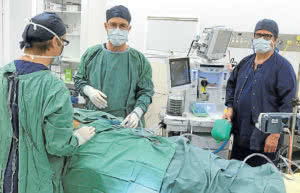Specialist treatment for ‘man boobs’
 For many men, the thought of taking off their shirt in public can cause a wave of anxiety. The beach, pool and change room at the gym become places to avoid.
For many men, the thought of taking off their shirt in public can cause a wave of anxiety. The beach, pool and change room at the gym become places to avoid.
Male breasts can evolve at any age. Known as gynaecomastia, the condition often begins in peri-pubertal males at about age 15-16. In later years, up to 70 per cent of men over the age of 50 are likely to have the condition.
It’s also common in users of anabolic steroids and occurs rarely as the result of medical diseases such as testicular cancer.
Dr Darrell Perkins is a plastic reconstructive surgeon at Sydney’s St George Private Hospital and Kareena Private Hospital. He also operates Aesthetic Day Surgery in Kogarah.
‘‘People present tome after they have seen their GP. They usually come saying, ‘I’m embarrassed to take my shirt off’,’’ Dr Perkins says.
‘‘I get 30-year-old guys who date their problem back to age 15. ‘‘They spend their life avoiding going to the beach.’’ The cause of gynaecomastia is not known, although it is believed to be linked to changes in hormones.
Dr Perkins says boys aged 15-16 will often begin to grow breast tissue as their hormones change with puberty. One breast can be larger than the other.
The condition is common among users of anabolic steroids. Steroids pump testosterone into the body.
As the testosterone breaks down, it produces oestrogen-like products that cause proliferation of breast tissue. ‘‘There’s a thousand old wives’ tales on the internet about what you do to stop ‘man boobs’ – none of them work.’’
Dr Perkins performs male breast surgery on gynaecomastia patients. The day surgery operation is carried out under general anaesthetic.He removes fat and breast tissue from the breast area, leaving muscle intact.
For many men, the biggest fear about breast surgery is their mates finding out. ‘‘Guys don’t care about scars but they don’t want anyone to know they have had breast surgery,’’Dr Perkins says. ‘‘Young 16-year-old guys do not want their mates to know they have had a breast reduction.’’
For this reason, Dr Perkins uses deliberate asymmetrical incisions away from the areola. ‘‘The scars look like mole excisions or football sprig marks; there are no ‘‘breast’’ incisions as such,’’ he says. ‘‘I have had patients swim at the beach happily with no cover after one week.’’
Gynaecomastia is a medical condition covered by Medicare and some health funds. However, Dr Perkins stresses that anyone who feels a lump or irregularity in their chest should see their GP promptly and have it investigated to exclude the possibility of breast cancer.






